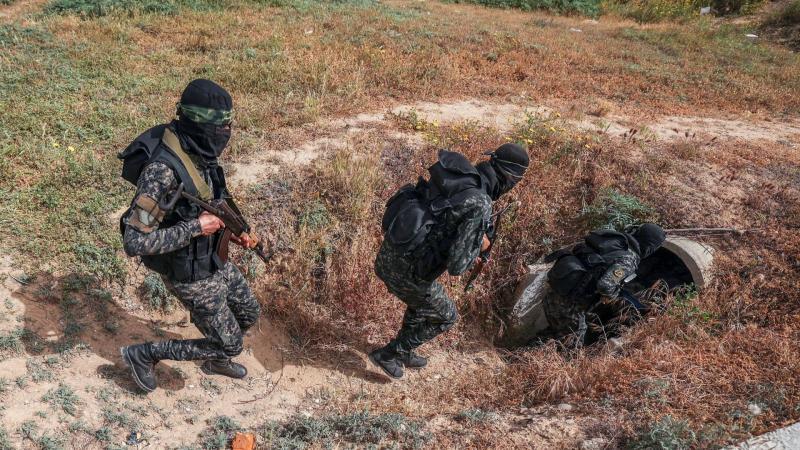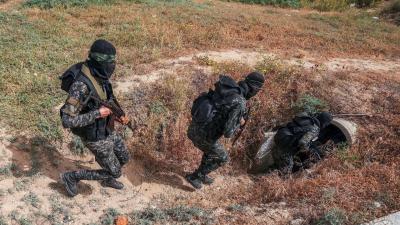The number of Israeli soldiers killed in Gaza has nearly doubled compared to the losses sustained during Israel's ground offensive in 2014, reflecting the extent of Israel's military incursion into the territory and the skill of Hamas in utilizing guerrilla warfare tactics and its extensive arsenal of weapons. Israeli military experts, an Israeli commander, and a source from Hamas revealed how the Palestinian movement leverages its stockpile of weapons and its knowledge of the terrain and extensive tunnel network to transform the streets of Gaza into a deadly maze.
Hamas employs weapons such as drones equipped with hand grenades and dual-explosive anti-tank weapons, which detonate in quick succession. Since the start of the Israeli ground campaign in late October, approximately 110 Israeli soldiers have been killed as tanks and infantry troops entered cities and refugee camps, according to official Israeli figures. Nearly a quarter of this number was from tank crews. This compares to about 66 soldiers who died during the 2014 conflict when Israel launched a limited three-week ground incursion, at which time the goal was not to eliminate Hamas.
Retired Israeli General Yaakov Amidror, a former national security adviser currently at the Jewish Institute for National Security of America, stated, "The scope of this war cannot be compared to 2014, when our operations mostly did not exceed one kilometer inside Gaza." He added that the army "has not yet found a good solution for the tunnels," a network that has expanded significantly over the past decade.
The Israeli assault began after Hamas militants crossed the border on October 7, leading to the deaths of 1,200 people and the capture of over 200 hostages, some of whom were released later. Since the outbreak of the war, nearly 19,000 Palestinians in Gaza have been killed, prompting international calls for a ceasefire and U.S. demands for Israel to modify its war strategy and conduct more precise strikes.
Israeli Prime Minister Benjamin Netanyahu stated on Thursday that Israel would wage war "until a clear victory." Israeli officials indicated that it could take months to conclude the war. Ofir Falk, Netanyahu’s foreign policy adviser, told Reuters, "It has been a challenge since day one," adding that the assault has come at a "heavy price" for Israeli forces. He continued, "We know that we will likely have to pay an additional price to complete the mission."
Hamas released video clips on its Telegram channel this month showing fighters moving through buildings with cameras to launch shoulder-fired rockets at armored vehicles. One of these clips published on December 7 was from the Shuja'iyya neighborhood east of Gaza City, an area both sides reported as experiencing heavy fighting. Another post from December 5 showed a camera exiting a tunnel, resembling a scope to survey a resting Israeli camp, which was later indicated to have been attacked from underground.
A source from Hamas, who spoke to Reuters from within Gaza but requested anonymity, mentioned that fighters get as close as possible to set ambushes, "taking advantage of their field expertise and the land they know better than anyone else." He added, "There is a gap between what we have in terms of power and their arsenal; we are not fooling ourselves."
Hamas did not disclose the number of fighters killed on its side. The Israeli army reported that it had killed at least 7,000 militants. The movement previously rejected the number provided by Israel, claiming it includes civilians. Hamas spokespeople outside Gaza did not respond to Reuters' requests for comment. An Israeli commander who fought in 2014 stated that the expanded scope of this operation indicates a larger number of forces on the ground, granting Hamas the "advantages of the defending side," making greater losses for Israeli forces expected. The commander requested anonymity as he remains part of the reserve forces in this war.
The Israeli army does not announce the number of troops involved or any other operational details. Footage broadcast by Israeli Channel 12 showed a reserve unit of the army cautiously firing at the wall of a building to enter a room and discover a weapons cache. In a continuation of tactics used in 2014, the Israeli army shares photos on social media showing paths created by bulldozers to help forces avoid existing roads that could contain landmines. Violent fighting continues in some areas of northern Gaza, where many buildings have been reduced to rubble.
Gaza-made munitions provide a larger stockpile of weapons for Hamas. Eyal Ben-Zur, a former senior Israeli security official now at the Begin-Sadat Center for Strategic Studies at Bar-Ilan University, stated, "Hamas has taken significant steps to build its strength since 2014." He noted that Iran, a Hamas ally, has assisted in smuggling some advanced weapons, such as Russian-made Kornet anti-tank missiles, to the group. However, he pointed out that Hamas has also mastered the production of other weapons in Gaza, such as RPG-7 rockets, leading militants to now have a greater reserve of munitions.
The movement claimed in its posts that its weapons include anti-tank missiles containing two explosive charges for penetrating armor, which Ben-Zur also confirmed exist in the fighters' arsenal. Video clips released by Hamas frequently show significant explosions when striking armored vehicles. Israeli military experts stated that an explosion does not necessarily mean the vehicle is destroyed as it could result from defensive systems detonating to stop incoming projectiles. Ashraf Abu al-Hol, editor-in-chief of the Egyptian newspaper Al-Ahram, who previously worked in Gaza and specializes in Palestinian affairs, noted that militants get as close as possible to launch rockets and locally-made projectiles.
However, he added that Israeli drones and other tools weaken Hamas's ability to surprise troops even in urban areas, making fighting in cities more challenging for militants. The Israeli army released a video this month that it claimed shows militants emerging from a tunnel beneath a building that was bombed before being targeted by missiles. Alexander Greenberg, a former Israeli military intelligence official now at the Jerusalem Institute for Strategy and Security, stated, "Hamas may deploy its weapons and new tactics, but essentially, it remains a guerrilla resistance movement."




